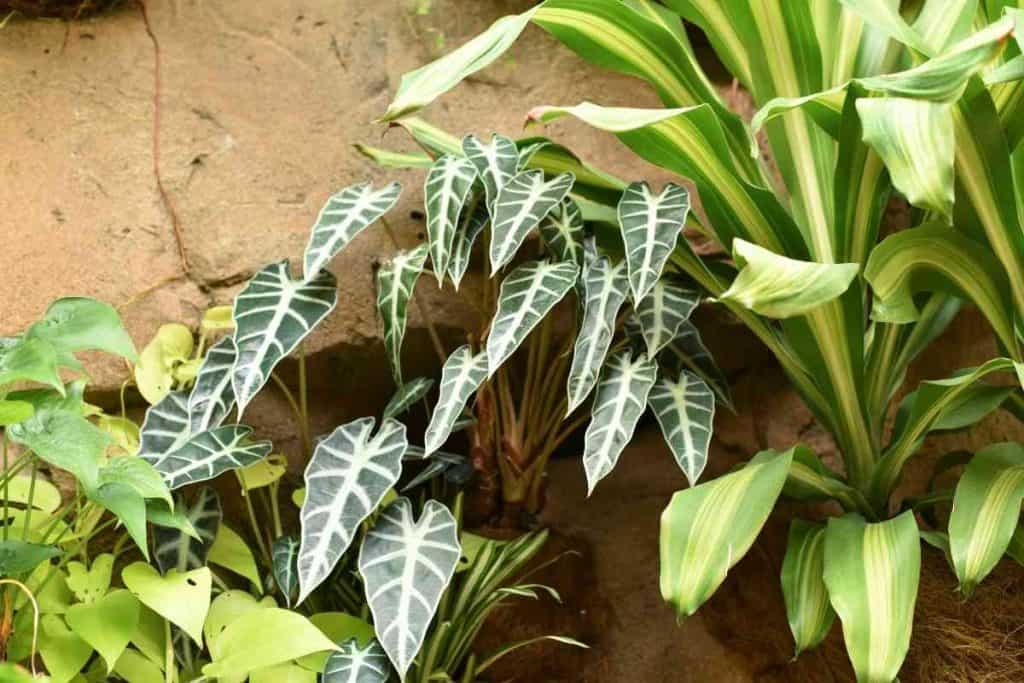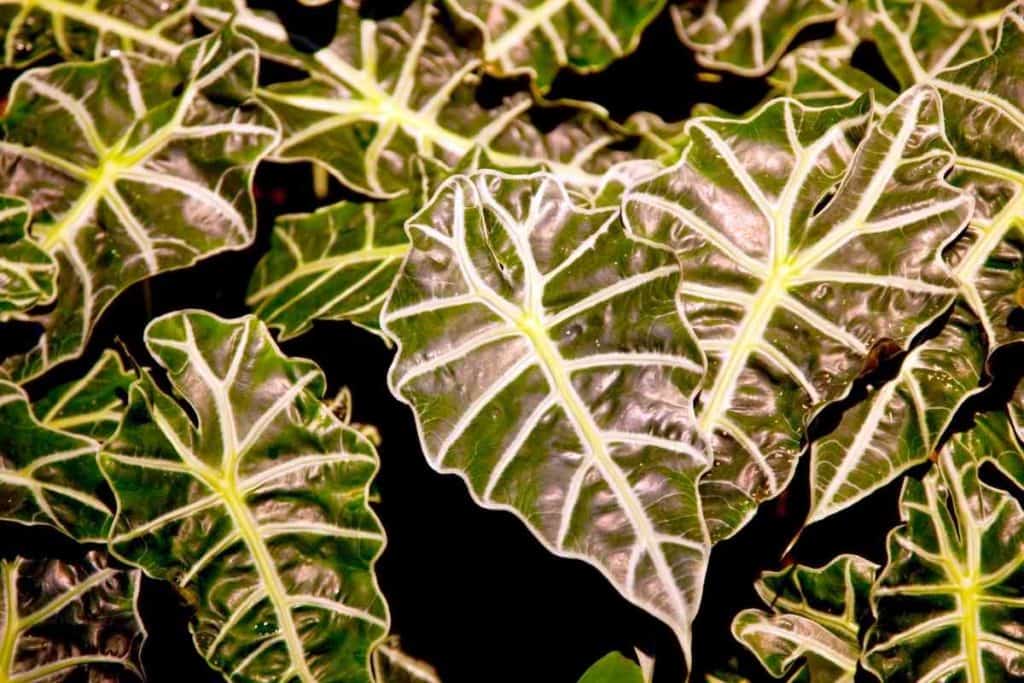We bring you another exciting and beautiful leafed plant that you can add to your indoor collections, otherwise known as Alocasia Bambino.
Scientifically known as Ficus lyrata bambino, the bambino is a dwarf version of fiddle leaf fig but not a hybrid. It features attractive arrowhead green leaves with a purple underside and patterned venation.
Proper care is needed if you must maintain its beauty and healthy appearance. For instance, alocasia bambino thrives under bright, indirect sunlight requires regular watering (make sure the soil is dry out between watering). It requires well-draining soil and doesn’t need extra humidity.
There’s no need to fertilize alocasia bambino, as the potting soil comes with every nutrient it needs.
This article details how to care for the alocasia bambino plant!
Table of Contents
What is Alocasia Bambino? | Alocasia Bambino Origin
| Common Name | Jewel Alocasia, Elephant Ear |
| Botanical Name | Alocasia bambino arrow |
| Plant Type | Aroid, Tropical |
| Family | Alocasia genus, Araceae |
| Sun Exposure | Bright, Indirect Light |
| Mature Size | Up to 40cm (12 to 14 inches) tall and wide |
| Soil Type | Aroid, Well-draining, Loamy soil |
| Leaf Color | Dark Green |
| Native Area | Native to Southeast Asia & Australia |
| Temperature | Between 65ºF to 75ºF (18 to 24ºC) |
| Toxicity | Toxic to both humans and animals when eaten |
| Cool Hardiness | USDA Zones 3 to 11 |
Alocasia Bambino is arguably one of the best and most popular decorative plants of the alocasia genus species.
Without a more careful look, you would be mistaken for the bambino variety for alocasia amazonica since they are somewhat identical in nature and features. And that explains why it is mostly considered an average amazonica or its cultivar.
Like most other alocasias, it is a bit tricky to grow the bambino variety, which is why as a beginner, you need deep knowledge about it if you need it among your indoor collections.
It comes with gorgeous arrowhead leaves with a purple underside and features a bright, patterned venation at the top.
Even though the alocasia bambino is very tricky to grow, it is not too hard to care for indoors, as long as you can provide it with its appropriate care routines such as bright, indirect light, moderate watering, high humidity levels, and average temperature amongst others.
As we discussed earlier, alocasia bambino is a cultivar of alocasia amazonica, which means that it is formed in cultivation via selective breeding and doesn’t happen naturally.
It is a dwarfed version of the amazonica, and its mature height is not below 12 inches tall, which makes it an excellent prospect for small space rooms.
Is Alocasia Bambino Easy To Care For?
Native to Southeast Asia, the dwarf alocasia bambino is a relatively easy indoor plant to grow successfully. In other words, despite how attractive the alocasia bambino is, caring for it is quite trickier than most other houseplants.
However, once you get used to its recommended care routine and apply them when necessary and as required, you’ll enjoy this beauty.
How to Care For Alocasia Bambino

Natural Habitat & Light Requirements
Like several other alocasia varieties such as the alocasia Polly, the natural habitat for the alocasia bambino is its tropical zone in southeast Asia and Australia. It never originated in the Amazon or its environs.
In its natural habitat, this variety does not thrive under direct sun, as taller trees act as shade to protect the plant from the direct heat of the sun.
However, it also requires light; filtered sunlight will do. Indoors, you can place it close to a windowsill spot with more light, but not to be exposed to the excessive impact of the sun.
Watering Requirements
Watering routine is usually the trickiest and most challenging aspect of the alocasia bambino care. Therefore, you should be very mindful of its watering, given its origin in the tropical areas of South East Asia and Australia, where it thrives under dry climates.
In other words, do not water excessively. And like most other alocasia varieties, watering of the bambino should be carried out weekly, when the top inches of the soil is dry, and with regular misting, to help keep the soil moist rather than wet.
Just as it doesn’t like to be overwatered, it also hates to be underwatered for a long time, as it’ll turn its leaf edges to brown.
Humidity and Temperature
Usually, every plant likes warmer temperatures and dislikes very cold conditions. The alocasia bambino is not exempted, as it very much doesn’t tolerate lower temperatures. The best temperature condition for the alocasia bambino should range between 65ºF to 75ºF (18 to 24ºC).
Humidity-wise, like every other tropical plant, the alocasia variety does best in higher humidity levels of around 60% and is, therefore, very successful when there is moisture in the air. You can place the plant closer to the shower or mist it frequently to promote its humidity.
Soil Requirements
The best soil for the alocasia bambino is a well-draining soil. Such kind of soil is usually made up of many organic matters like coco coir and perlite or vermiculite, which will enhance its drainage. The added handful of perlite to the regular purchased potting mix is ideal.
The jewel alocasia plant, as it is popularly called, thrives in moist, rich organic soil. Therefore, you must ensure you avoid wet, mucky, or dry, sandy soils and instead use loamy soil.
In other words, do not allow the soil to keep water for too long to avoid root rot because, at this stage, it can no longer absorb moisture.
Fertilizing Needs
It is quite necessary to feed your alocasia bambino properly, as it will help the plant produce huge, gorgeous leaves. The best time to feed it should be during its active growing stage under warmer seasons. Try to use a ¼ diluted full liquid fertilizer while watering.
Seaweed or fish emulsion is also highly recommended. Like other alocasias, the bambino requires its beauty rest and needs a dormant time. Avoid feeding the plant in the frost seasons when it is not actively growing.
Planting (Potting & Repotting)
The best time to repot your alocasia bambino is at least two to three years. Because it is a dwarf alocasia variety, do not be in a hurry to repot it into a bigger vessel.
The perfect repotting time is usually during the propagation process during the summer or spring periods, as it helps its damaged roots to develop well during this period (growing seasons).
How to Prune Alocasia Bambino

There are one of two reasons why several plants require pruning. It’s either you are pruning them to stop them from becoming too long, huge, or unruly, or you are doing so to keep them healthy.
But as long as the alocasia bambino is concerned, it is pruned regularly to ensure it’s dry, tidy, and dust-free. It is necessary to cut off dead or dying leaves to stop the plant from wasting resources and free from germs and pests.
Alocasia Bambino Propagation
Alocasia bambino can be propagated in many ways, but the best method is by dividing rhizomes, and the perfect time to do this is in the summer and spring seasons.
But before you begin, ensure that all your tools are sterilized and have the right clothing for the methods.
Below are the steps required to propagate the alocasia bambino by division of rhizomes:
- Choose a completely mature Alocasia Bambino plant. And ensure it is healthy and hydrated.
- Get rid of the parent Bambino plant from its vessel and separate it into rhizomes.
- After that, it is time to move the parent plant into a fresh container or repot it into the previous one.
- Sow the divided rhizomes into their chosen pots using the right soil mix.
- Ensure that the rhizome is upright. This can be done by pressing the surrounding soil of the rhizome.
- You can now position the rhizomes in their right conditions with warmer temperatures, high humidity levels, and under the required indirect sunlight.
- Water the plant as often as required and feed the rhizome with its right nutrient during the initial growing weeks.
Frequently Asked Questions
Why is My Alocasia Bambino Dying?
The reason why your alocasia bambino is fading out or dying is because of overwatering, underwatering, temperature stress, and inadequate nutrient. If you want to revive the plant, you must water it whenever the top two inches of soil is dry and use a pot with well-drainage soil and system.
Why is My Alocasia Bambino Leaves Turning Yellow?
One of the common reasons why your alocasia bambino leaves are turning yellow is because of the wrong soil moisture. In other words, when you overwater, it will not bode well for the plant, as the plant prefers to be watered but not excessively. Therefore, it is essential to maintain a regular watering routine.
Should I Mist My Alocasia Bambino?
Like several varieties out there, your alocasia will do well in humid conditions; therefore, you can mist it as often as required. Mist the leaves continuously with a mister, place a humidifier close by, or use a pebble tray to increase its humidity. Also, keep its temperature between 65ºF to 75ºF.
Is Alocasia Bambino the same as Polly?
You can say they are almost similar and has nearly identical features. In other words, it is a dwarfed, more compact version of alocasia Polly amazonica and has spear-shaped leaves with very glossy, dark green leaves and broad, bold, and white veins. Just like its sister plant, it thrives under bright light conditions but not direct sunlight.
How often do you Water Alocasia Bambino?
Alocasia bambino needs weekly watering schedules and regular misting to help maintain a certain moisture level in their soil. During the winter season, you must water only when the top 2 inches of the soil is dried between watering, thus, preventing excessive watering and, subsequently, root rot.
Is Alocasia Bambino Toxic to Cats and Dogs?
Like other alocasia species such as the alocasia Polly, the alocasia bambino is toxic to cats and dogs. It has calcium oxalate crystals content that causes a burning sensation whenever you touch or eat it. Therefore, make sure it is out of the reach of your kids and pets.
Related Posts:
- Alocasia Sinuata Vs Baginda
- Alocasia Maharani Care
- Alocasia Sumo Care and Growing Tips
- Alocasia Azlanii Care and Growing Tips
- Anthurium Clarinervium Care




